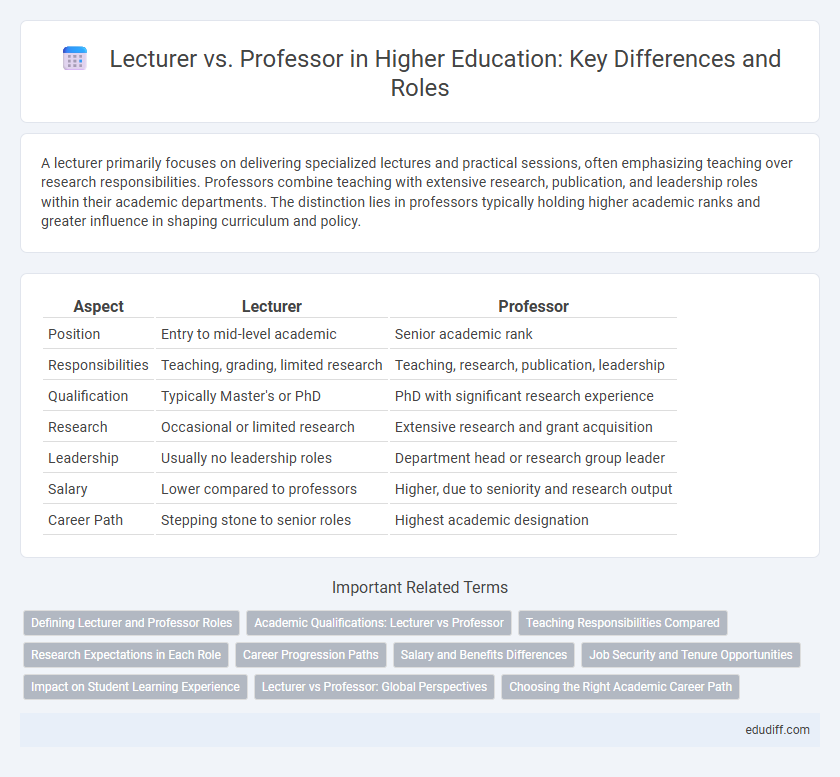A lecturer primarily focuses on delivering specialized lectures and practical sessions, often emphasizing teaching over research responsibilities. Professors combine teaching with extensive research, publication, and leadership roles within their academic departments. The distinction lies in professors typically holding higher academic ranks and greater influence in shaping curriculum and policy.
Table of Comparison
| Aspect | Lecturer | Professor |
|---|---|---|
| Position | Entry to mid-level academic | Senior academic rank |
| Responsibilities | Teaching, grading, limited research | Teaching, research, publication, leadership |
| Qualification | Typically Master's or PhD | PhD with significant research experience |
| Research | Occasional or limited research | Extensive research and grant acquisition |
| Leadership | Usually no leadership roles | Department head or research group leader |
| Salary | Lower compared to professors | Higher, due to seniority and research output |
| Career Path | Stepping stone to senior roles | Highest academic designation |
Defining Lecturer and Professor Roles
Lecturers primarily focus on delivering undergraduate teaching and developing course materials, often without significant research responsibilities. Professors hold advanced academic ranks involving both teaching and leading original research projects, supervising doctoral candidates, and contributing to academic administration. The differentiation centers on research output, academic leadership, and tenure status within higher education institutions.
Academic Qualifications: Lecturer vs Professor
Lecturers typically hold a master's degree or a doctorate, while professors almost always possess a PhD or an equivalent terminal degree, reflecting higher academic qualifications. Professors often have a substantial record of published research, advanced teaching experience, and contributions to their academic field. The progression from lecturer to professor generally requires significant scholarly achievements, including securing research grants and participating in academic leadership.
Teaching Responsibilities Compared
Lecturers primarily focus on delivering undergraduate and some postgraduate courses, dedicating most teaching hours to lectures, seminars, and tutorials. Professors often balance teaching duties with research leadership but typically oversee advanced graduate seminars and supervise doctoral candidates. In many institutions, professors have reduced teaching loads to accommodate administrative roles and extensive research commitments.
Research Expectations in Each Role
Professors are typically expected to lead significant research projects, publish extensively in peer-reviewed journals, and secure research funding, reflecting their senior academic status. Lecturers often focus more on teaching and may engage in research, but the scale and impact expectations are generally lower compared to professors. Research output, grant acquisition, and contribution to academic knowledge are key performance indicators that distinguish professors in higher education institutions.
Career Progression Paths
Lecturers often begin their academic careers with a focus on teaching and may advance to senior lecturer roles before pursuing professorships, which require significant research achievements and publications. Professors typically hold higher institutional rank and greater responsibilities, including leadership in academic departments and securing research funding. Career progression from lecturer to professor involves continuous professional development, contributions to academia, and peer recognition through tenure and promotion processes.
Salary and Benefits Differences
Lecturers typically earn a lower salary compared to professors, reflecting differences in academic rank, experience, and job responsibilities. Professors often receive enhanced benefits such as research funding, sabbaticals, and higher retirement contributions, which align with their senior status and tenure-track positions. Salary ranges for professors can exceed $100,000 annually at major universities, while lecturers' earnings generally fall between $40,000 and $70,000 depending on institution and location.
Job Security and Tenure Opportunities
Professors typically enjoy greater job security due to tenure opportunities that protect them from arbitrary dismissal, ensuring long-term academic stability and career progression. Lecturers often face contract-based employment with limited or no access to tenure, resulting in less predictable job security and more frequent contract renewals. Institutions prioritize tenure-track positions for professors, reflecting their strategic role in research and academic governance, while lecturers primarily focus on teaching duties with fewer tenure pathways.
Impact on Student Learning Experience
Lecturers often provide practical, application-focused teaching that enhances student engagement and real-world skill development, directly impacting learning outcomes. Professors typically contribute through advanced research integration and theoretical depth, enriching the academic rigor and critical thinking abilities of students. Both roles shape the student learning experience by balancing practical knowledge and scholarly insight, fostering comprehensive educational growth.
Lecturer vs Professor: Global Perspectives
Lecturers typically concentrate on teaching responsibilities while professors engage extensively in research, publication, and academic leadership globally. In countries like the UK and Australia, lecturers are often early-career academics, whereas professors hold senior, tenured positions with significant influence on curriculum development. Cross-national variations highlight differences in academic rank structures, expectations for tenure, and the balance between teaching and research duties.
Choosing the Right Academic Career Path
Choosing between a lecturer and professor role depends on your career goals, research ambitions, and teaching preferences. Professors typically engage in extensive research, publish academic papers, and hold permanent tenure, while lecturers often focus primarily on delivering lectures and may have contract-based positions. Evaluating factors like job security, research funding, academic influence, and workload will help determine the most suitable academic career path.
Lecturer vs Professor Infographic

 edudiff.com
edudiff.com